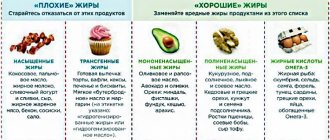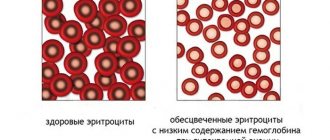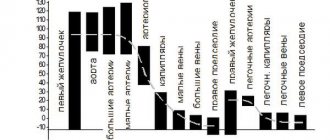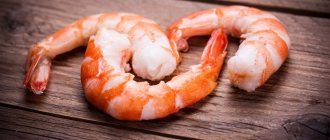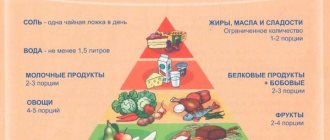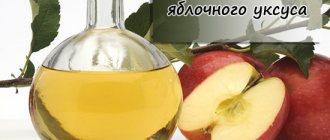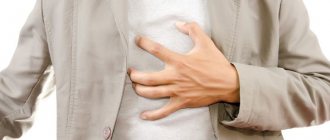Atherosclerosis as a consequence of high cholesterol levels is relevant for both sexes, but under 50 years of age this problem is less common among women. Men already from the age of 30 are at risk due to physiological characteristics and lifestyle. Nutrition plays a significant role in cholesterol metabolism, since a fifth of lipoproteins and triglycerides enter the body with food. The remaining 80% are of endogenous origin, so if the norm is exceeded, not only a diet for high cholesterol in men may be required, but also specific medications, a review of lifestyle, and giving up bad habits.
Causes of increased cholesterol levels and normal levels in men
As biochemical blood tests show, the level of low-density lipoproteins in the blood increases as the body ages. The average maximum value is 5.2 mmol/l. If this milestone is reached, it’s time to think about revising your diet, and an increase by a few units is a reason for drug therapy.
Up to 30 years of age, such values in men are not dangerous, since the metabolic rate is quite high. But at a later age, the atherogenicity of cholesterol increases and it begins to settle in plaques on the walls of the arteries. Women in this age group are protected by a hormonal background in which estrogens predominate, but among the stronger sex the incidence of strokes and heart attacks increases sharply.
Why are men after 30 susceptible to the negative effects of cholesterol? Common causes include hereditary pathologies, inactivity and overeating, and disruptions in the endocrine system. Specific “male” factors include:
- High-calorie foods, consisting mainly of fats and carbohydrates, and poor diet. It is believed that a man should eat a lot and eat heavily, and the modern rhythm of life also contributes to the frequent consumption of fast food rich in trans fats and irregular meals.
- The presence of habits that have a harmful effect on the functioning of the cardiovascular system, such as smoking and drinking alcohol.
- Chronic stress. This factor also negatively affects the health of women, but the difference in the emotional behavior of both sexes allows women to periodically “relieve tension,” while the stronger half of humanity accumulates negative emotions.
Therefore, men starting from the age of 30 are advised not to avoid preventive medical examinations and regularly check their cholesterol levels. Small deviations will help adjust a balanced diet for high blood cholesterol in men and avoid some potentially dangerous foods. In more serious cases, drug therapy is indicated.
Read further: Table with cholesterol standards for men by age
What folk recipes are allowed by doctors?
For the first recipe you need to have half a glass of dill seeds, a dessert spoon of grated valerian root and 100 g of fresh honey . All these ingredients are thoroughly mixed, diluted with one liter of boiling water, and left for 24 hours. The resulting tincture is stored on the bottom shelf of the refrigerator. Take one spoon three times a day half an hour before meals.
The second recipe calls for two cups of quality olive oil and ten cloves of fresh garlic . The method of preparing garlic oil is easy, and it can be used as a dressing for any type of dish. You just need to peel the garlic cloves, pass them through a press, and pour the resulting pulp into olive oil. Infuse for seven days - the cholesterol-lowering oil is ready.
Men who want to lower their cholesterol levels need to adhere to a diet constantly. But it is also necessary to ensure that a balance is maintained between energy intake and energy expenditure. The diet should be varied, high quality and healthy.
The anti-cholesterol diet is designed taking into account all these nuances. Unauthorized adjustments to the dietitian’s prescriptions can threaten a man with a deterioration in the condition of the cardiovascular system.
Do you like the article? Rate and share with friends on social networks!
Rate our article on a 5-point scale -
(
1 ratings, average: 5.00 out of 5) Your opinion is very important to us!
Subscribe to site updates via RSS, or follow updates on VKontakte, Odnoklassniki, Facebook or Twitter.
Subscribe to updates by E-Mail:
Tell your friends! Share this article with your friends on your favorite social network using the buttons below the article. Thank you!
Other interesting articles
For health 09:41
Principles of nutrition
There is no need to be afraid that you will have to eat monotonously and tastelessly. In fact, switching to a healthy diet does not imply giving up delicious food, you just need to slightly reduce the calorie content of the menu and reconsider your eating regimen:
- Make the basis of the diet (about 60% of the total) complex carbohydrates - cereals, legumes, vegetables and fruits. Due to pectin, fiber and glycogen, they help normalize the level of not only cholesterol, but also sugar, and reduce the risk of obesity.
- Refuse fatty meat in favor of dietary meat. That is, instead of pork or duck, eat lean rabbit and chicken. Consumption of fish is not limited, since the fat it contains is unsaturated, promoting the synthesis of HDL (“good” cholesterol).
- Eat less bread, giving preference to bread prepared with the addition of bran, as well as day-old rye. The recommended daily intake is 200 grams.
- Reduce the amount of sugar and salt in food. Food should be salted immediately before consumption and very moderately (up to 3 g per day), and harmless substitutes should be used instead of pure sugar.
- A diet for high cholesterol in men requires a special diet. There should be 5 meals, with an interval of no more than 3 hours between them, and portions should be small.
- The method of preparation also matters. Stewing, boiling or baking are preferable, but you should fry foods as little as possible.
Lovers of coffee, strong alcohol, soda and rich black tea will have to give up these drinks in favor of juices, compotes and fruit drinks. But beer is not contraindicated, and on the contrary, it is beneficial. However, it should be borne in mind that the maximum daily dose is 0.5 liters, and the beer itself must be fresh and natural (that is, not contain chemical preservatives, sugar and other harmful ingredients).
Diet and age
The diet should be compiled not only taking into account the person’s diagnosis, but also based on his age. The older the patient, the higher his risk of cardiovascular pathologies and hormonal disorders, as well as chronic diseases, which must be taken into account when creating a menu.
- Up to 30 years old. At a young age, metabolism is at its highest level, so even the presence of chronic diseases and poor nutrition does not always cause changes in cholesterol levels. But it is at this stage that it is important to normalize your diet in order to maintain health for many years. If the patient is a man under the age of 30, the doctor recommends that he first give up bad habits, learn to cope with stress correctly, and also start eating healthy foods, not fast food.
- Up to 45-50 years old. After 30 years, the menu should focus on vegetables, fruits and seafood, and regularly eat poultry meat, such as chicken or turkey. After approximately 40 years, the level of testosterone, the main male hormone, begins to decrease, changes in the level of which lead to various pathologies, including atherosclerosis. You can help your hormonal system return to normal by giving up excess meat in favor of fish, and also drinking less coffee and tea.
- Up to 60 years old. Men aged 50 to 60 experience a slowdown in their metabolic processes, causing cholesterol to rise even in healthy men. The goal of the diet is to speed up metabolism. During this period, it is especially important to eat often, but in small portions. Vegetables, fruits, fish and mushrooms should be present on the table every day. You can eat meat no more than twice a week.
- Up to 70 years old. After age 60, cholesterol usually stabilizes and no longer rises. It is also not possible to reduce it to normal levels with the help of nutrition, so patients usually take special drugs - statins. However, even at this time, it is extremely important to monitor your diet to ensure that your diet includes sufficient amounts of iron, iodine and zinc. This will help prevent dangerous pathologies associated, among other things, with vessels affected by atherosclerotic plaques.
After 70 years, the risk of cardiovascular accidents increases significantly. To prevent this from happening, it is necessary not only to monitor the amount of cholesterol consumed, but also to eat a sufficient amount of foods with vitamin C and rutin, which will help strengthen vascular tissue and increase its elasticity.
List of what not to eat if you have high cholesterol
Certain foods with an increased risk of developing atherosclerosis will have to be completely abandoned. The “record holders” for the content of cholesterol and substances that promote its synthesis in the body are the following:
- fatty meat and poultry - beef, pork, duck;
- offal - liver, brains, kidneys;
- cheeses, butter, other dairy products with a high percentage of fat;
- margarine, animal fats, lard;
- smoked meats, sausages and canned goods;
- sweets, baked goods, confectionery;
- alcoholic drinks, lemon, strong tea and coffee.
It is necessary to exclude the listed foods from the diet for at least three months if the level of cholesterol in the blood exceeds normal levels.
Blood cholesterol level
Diagnosis of hypercholesterolemia is based on a biochemical study of the blood lipid profile. At the same time, the level of cholesterol, high and low density lipoproteins is determined in a man. This is due to the fact that it is not just cholesterol that affects the risk of developing vascular pathology, but a combination of these substances.
Normal blood cholesterol levels vary depending on age and tend to increase as people get older and older. The table displays the ranges of normal lipid levels in men by age group.
The table shows that lipid profile norms vary by age. For example, cholesterol levels in men after 30 years of age differ significantly from normal levels in adolescence.
Only the attending physician should interpret the test results!
Need for cholesterol
The daily requirement for cholesterol is almost identical for representatives of different genders and ages. As a rule, our body needs 800-1200 mg of cholesterol per day. However, most of this amount (60-70%) is produced by liver cells and is not associated with food intake. Therefore, cholesterol intake from food should not exceed 300 mg per day. Otherwise, even the diet itself can become a key factor in the development of hypercholesterolemia.
What must be on the menu
The basis of the diet is products to lower blood cholesterol in men, which cleanse the body of excess LDL. The list includes:
- cooked and fresh vegetables, fruits;
- cereals, bran bread, legumes;
- sea fish containing many polyunsaturated fatty acids;
- egg whites as protein sources;
- vegetable oils;
- soy and mushrooms;
- dairy and fermented milk products with a low percentage of fat;
- green tea, fruit drinks, compotes, freshly squeezed juices from fruits and vegetables.
It is useful to add garlic and some spices (for example, turmeric) to food. You can also include pasta, egg yolks, and lean meat in the menu, but in limited quantities.
Authorized Products
Proper nutrition for high cholesterol should become the norm. What should it be? First of all, you need to exclude meat broths - prepare vegetarian soups; if this is difficult and unusual for you, then you can use weak secondary broth for first courses and carefully skim off the fat. Use potatoes in minimal quantities and it is better to prepare combined vegetable soups, cabbage soup and borscht.
Meat and poultry should be taken of lean types; poultry skin is unacceptable; additional fat should be trimmed from the meat. Since the diet involves limiting fat, the meat should be boiled or baked without adding sour cream, mayonnaise or any fat. Use vegetables as a side dish, not cereal. It is better to cook them for breakfast (oatmeal, buckwheat and brown rice).
Cabbage (all types), carrots, zucchini, pumpkin, eggplant, or salads made from fresh vegetables and green peas will help lower cholesterol levels. The total amount of vegetables eaten per day is at least 400g.
Use virgin vegetable oils to season ready-made dishes. omega-3 fatty acids, which regulate the production of beneficial lipids, is useful in this regard .
Lowering cholesterol levels can be achieved by introducing low-fat sea fish into the diet, but the consumption of meat (chicken) should still be limited to once a week. When it comes to fish, you should choose dietary varieties: hake, haddock, blue whiting, navaga, pollock, pollock.
Bread made from rye, grain flour and bran is allowed. You can use yeast-free bread (with bran, with flax seeds) for snacks and first courses. Milk and fermented milk products are allowed only in low fat content and in limited quantities. Green tea and weak coffee with milk and without sugar, vegetable and fruit juices without sugar are allowed.
Table of permitted products
| Proteins, g | Fats, g | Carbohydrates, g | Calories, kcal | |
Vegetables and greens | ||||
| eggplant | 1,2 | 0,1 | 4,5 | 24 |
| beans | 6,0 | 0,1 | 8,5 | 57 |
| zucchini | 0,6 | 0,3 | 4,6 | 24 |
| cabbage | 1,8 | 0,1 | 4,7 | 27 |
| broccoli | 3,0 | 0,4 | 5,2 | 28 |
| Brussels sprouts | 4,8 | 0,0 | 8,0 | 43 |
| cauliflower | 2,5 | 0,3 | 5,4 | 30 |
| green onion | 1,3 | 0,0 | 4,6 | 19 |
| bulb onions | 1,4 | 0,0 | 10,4 | 41 |
| carrot | 1,3 | 0,1 | 6,9 | 32 |
| cucumbers | 0,8 | 0,1 | 2,8 | 15 |
| squash | 0,6 | 0,1 | 4,3 | 19 |
| salad pepper | 1,3 | 0,0 | 5,3 | 27 |
| parsley | 3,7 | 0,4 | 7,6 | 47 |
| salad | 1,2 | 0,3 | 1,3 | 12 |
| beet | 1,5 | 0,1 | 8,8 | 40 |
| celery | 0,9 | 0,1 | 2,1 | 12 |
| soybeans | 34,9 | 17,3 | 17,3 | 381 |
| asparagus | 1,9 | 0,1 | 3,1 | 20 |
| tomatoes | 0,6 | 0,2 | 4,2 | 20 |
| Jerusalem artichoke | 2,1 | 0,1 | 12,8 | 61 |
| pumpkin | 1,3 | 0,3 | 7,7 | 28 |
| dill | 2,5 | 0,5 | 6,3 | 38 |
| beans | 7,8 | 0,5 | 21,5 | 123 |
| garlic | 6,5 | 0,5 | 29,9 | 143 |
| lentils | 24,0 | 1,5 | 42,7 | 284 |
Fruits | ||||
| avocado | 2,0 | 20,0 | 7,4 | 208 |
| oranges | 0,9 | 0,2 | 8,1 | 36 |
| pomegranate | 0,9 | 0,0 | 13,9 | 52 |
| grapefruit | 0,7 | 0,2 | 6,5 | 29 |
| pears | 0,4 | 0,3 | 10,9 | 42 |
| lemons | 0,9 | 0,1 | 3,0 | 16 |
| mango | 0,5 | 0,3 | 11,5 | 67 |
| tangerines | 0,8 | 0,2 | 7,5 | 33 |
| nectarine | 0,9 | 0,2 | 11,8 | 48 |
| peaches | 0,9 | 0,1 | 11,3 | 46 |
| apples | 0,4 | 0,4 | 9,8 | 47 |
Berries | ||||
| gooseberry | 0,7 | 0,2 | 12,0 | 43 |
| Red currants | 0,6 | 0,2 | 7,7 | 43 |
| black currant | 1,0 | 0,4 | 7,3 | 44 |
Nuts and dried fruits | ||||
| nuts | 15,0 | 40,0 | 20,0 | 500 |
| almond | 18,6 | 57,7 | 16,2 | 645 |
| flax seeds | 18,3 | 42,2 | 28,9 | 534 |
| fenugreek seeds | 23,0 | 6,4 | 58,3 | 323 |
| sunflower seeds | 20,7 | 52,9 | 3,4 | 578 |
Cereals and porridges | ||||
| buckwheat (kernel) | 12,6 | 3,3 | 62,1 | 313 |
| oat groats | 12,3 | 6,1 | 59,5 | 342 |
| cereals | 11,9 | 7,2 | 69,3 | 366 |
| wheat bran | 15,1 | 3,8 | 53,6 | 296 |
Raw materials and seasonings | ||||
| basil | 2,5 | 0,6 | 4,3 | 27 |
| honey | 0,8 | 0,0 | 81,5 | 329 |
Dairy | ||||
| kefir 0% | 3,0 | 0,1 | 3,8 | 30 |
| kefir 1% | 2,8 | 1,0 | 4,0 | 40 |
Cheeses and cottage cheese | ||||
| cottage cheese 0.6% (low fat) | 18,0 | 0,6 | 1,8 | 88 |
| curd tofu | 8,1 | 4,2 | 0,6 | 73 |
Meat products | ||||
| beef | 18,9 | 19,4 | 0,0 | 187 |
Bird | ||||
| chicken fillet | 23,1 | 1,2 | 0,0 | 110 |
| turkey | 19,2 | 0,7 | 0,0 | 84 |
Eggs | ||||
| eggs | 12,7 | 10,9 | 0,7 | 157 |
Fish and seafood | ||||
| fish | 18,5 | 4,9 | 0,0 | 136 |
| seaweed | 0,8 | 5,1 | 0,0 | 49 |
Oils and fats | ||||
| grape seed oil | 0,0 | 99,9 | 0,0 | 899 |
| linseed oil | 0,0 | 99,8 | 0,0 | 898 |
| olive oil | 0,0 | 99,8 | 0,0 | 898 |
| sunflower oil | 0,0 | 99,9 | 0,0 | 899 |
Non-alcoholic drinks | ||||
| mineral water | 0,0 | 0,0 | 0,0 | — |
| instant chicory | 0,1 | 0,0 | 2,8 | 11 |
| green tea | 0,0 | 0,0 | 0,0 | — |
| * data is per 100 g of product | ||||
Diet for high cholesterol in men
Each age period, starting from 30 years, has its own characteristics and dietary restrictions. So, from 30 to 40, the menu should be as varied as possible, lean meat should be eaten at least 3 times a week, and the average daily calorie intake should be about 2500-3000 kcal. However, the energy value directly depends on lifestyle: athletes require much more (up to 5000), and for sedentary work and excess weight - no more than 2000.
From 40 to 50 years of age, when age-related hormonal changes occur and metabolism slows down, the nutritional value of the daily diet should not exceed 2500-3000 kcal. Meat can be consumed no more than 3 times a week. A diet for high cholesterol after 50 years involves a complete rejection of coffee, salt and sugar, an almost complete replacement of meat dishes with fish and an increase in the proportion of low-fat dairy products in the menu. Nevertheless, you can eat tasty and quite varied food even with the most severe restrictions.
Read further: How to reduce blood cholesterol at home quickly and effectively?
Meal options
If you have difficulty choosing and preparing food, you can use the options below for each of the 5 meals. The menu for a week for a diet for high cholesterol in men after 50 years can include many nutritious and varied dishes.
First breakfasts
- porridges cooked with milk or water (except semolina);
- cottage cheese casserole or cheesecakes;
- toast with jam;
- steamed egg white omelette;
- kefir with muesli;
- a mixture of nuts, seeds and dried fruits.
Ginger or green tea are suitable drinks as they give a boost of energy and activate metabolic processes.
Second breakfasts
- vegetable salad with butter;
- fruit salad with honey;
- sandwich made from bran bread, low-fat cheese and vegetables;
- fermented milk drinks;
- nuts or seeds;
- fruit or vegetable juices.
Lunches
This meal should consist of a first course (vegetable soups or meat and fish broths) and a second course. Moreover, if there is meat or fish in the soup, then for the second course it is advisable to do without them, focusing on other products to reduce blood cholesterol in men.
- borscht or cabbage soup with lean meat;
- poultry broth;
- ear;
- mushroom soup;
- vegetable puree soup;
- baked fish or meat;
- vegetable stew;
- mashed potatoes;
- pasta;
- vegetable salads.
Afternoons
These meals help combat hunger between lunch and dinner, especially if protein dishes are served.
- fish or meat meatballs;
- omelette made from whole eggs or whites;
- steam cutlets;
- cheese casserole;
- milk, kefir.
Menu creation
Below is a universal diet suitable for men with high cholesterol.
First day:
- Breakfast – 150 ml of fresh orange juice and a couple of cheesecakes.
- Lunch – several peppers stuffed with rice and chicken fillet.
- Afternoon snack – 2 tomatoes or 1 large apple, 2 slices of Dutch cheese and a slice of whole grain bread.
- Dinner – vegetable borscht.
Second day:
- Breakfast – a glass of grapefruit juice and 150 g of vegetable salad.
- Lunch – rice porridge and 140 g of steamed chicken breast.
- Afternoon snack – 150 g low-fat curd mass.
- Dinner – vegetable salad or 150 g low-fat cottage cheese casserole.
The third day:
- Breakfast - omelet and fresh tomato.
- Lunch – vegetable soup and vegetable salad with the addition of cheese.
- Afternoon snack – low-fat yogurt.
- Dinner – 120 g of baked pink salmon and fresh cucumber.
Fourth day:
- Breakfast – buckwheat porridge and 50 ml of low-fat kefir.
- Lunch – pilaf with chicken fillet and 50 g of vinaigrette.
- Afternoon snack – banana and 50 g of baked pumpkin slices.
- Dinner – salad of fresh tomatoes and cucumbers.
Fifth day:
- Breakfast – low-fat cottage cheese and 10 ml of sour cream (low-fat).
- Lunch – fresh orange juice, cabbage soup and a boiled egg.
- Afternoon snack – persimmon or avocado.
- Dinner – durum wheat pasta and 50 g of feta cheese.
Sixth day:
- Breakfast – a slice of black bread and 200 ml of freshly squeezed vegetable juice.
- Lunch – assorted mushrooms and oatmeal.
- Afternoon snack – skim milk (150 ml).
- Dinner – 200 g of stewed salmon.
Seventh day:
- Breakfast: apple juice or low-fat yogurt.
- Lunch – wheat porridge and boiled rabbit meat.
- Afternoon snack – carrot and apple salad or 100 g of walnuts.
- Dinner – beet and apple salad or baked pumpkin.
Fresh vegetables and sea fish will help normalize cholesterol levels
